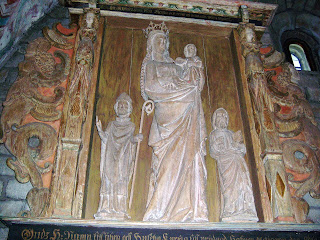Odin in Husaby
The Churches of Kinnekulle
A Story of Transitions
Transitions:
1. Religious
Proseletyzing for a new religion usually requires showing some connection between the old and the new. In that way, the crossover can be touted as voluntary, a needed step where there are no immediate armies of the new religion as backup, to kill the reluctant. The mainland Germanic tribes were subject to the killing approach of Charlemagne: it took time, but it ultimately worked. That was not feasible in Norway or Sweden, so the mythological parallel approach took over. The god sacrificing himself on a tree to achieve a higher goal. Common theme in many religions.
Odin. Odin hung on the Tree of Life, the Tree of the Lives, Yggdrasil, for nine days as a sacrifice so he could learn the secrets of the runes. See http://www.norse-mythology.com/Odin.html
Early representations of the crucifixion story (Christian) maximize the text that the crucifixion took place on a tree. See John references, http://bible.cc/acts/10-39.htm, they hung him on a tree. Use that wording, instead of cross, and the Odin idea of Odin who also hung in a tree, slid right over. Nothing to worry about here, folks, just keep moving. Just the same story. So, see the Swedish cross looking like a tree, with the branches nipped off:
 Crucifix incorporating Tree of the Lives motif (Odin suggestion), Husaby Kyrka, Kinnekulle
Crucifix incorporating Tree of the Lives motif (Odin suggestion), Husaby Kyrka, Kinnekulle Yggdrasil. This crucifixion is a fitting representation for this place. The cross as Tree. Tree of Life Yggdrasil. The tree imagery is also at Forshem Kyrka, http://swedenroadways.blogspot.com/2011/05/forshem-kyrka-interior-old-odin-traces.html The rosette at the foot of the tree-cross is a common medieval motif, like a solar cross symbol, but need to focus more on this particular one to figure out what it is.
2. Economic
A Treasure. Kinnekulle as biosphere.
Mount Kinnekulle has been a regional crossroads for shifts not just in religion, but in social and cultural change. Kinnekulle moved from a) as an economic entity, owners and workers, b) to current scientific and flora-fauna and geological interest, and c) to a recreational and hiking center, see http://www5.o.lst.se/projekt/kinnekulle/pdf/kinnekulle_naturskrift_eng.pdf.
Read the vision of a biosphere, see http://vanerkulle.org/vk//images/stories/files//245_BR_NOMINATION_Lake_Vanern_Archipelago_and_Mount_Kinnekulle.pdf
3. Kinnekulle as base for studying old Churches, how they changed.
Churches here have been enough off the beaten track to allow parts untouched, or easily restored. Find wide shifts in how the stories were told. And see the initial vitality in art and representation, turn to rigid Reformation, and then to relaxing back.
A progression of missionaries, from the 9th Century wooden stave churches, and those works did not last; to St. Sigfrid in the 11th Century, stone works, and those did last. The stone church era was decorative, full of art, expression, color, pattern, teaching tools on ceilings and on walls. Then came the Reformation. The colors were painted over in order to get rid of the distracting nonsense. Think Calvin. Concealment meant protection, however, and the works could be restored. Remember art class - the idea of horror vacui. Fear of empty spaces. Fill it all up. See it again now. Regardless of the angle of your head twisting up to see, there is something facing yo.
The dominance of women in early representations in Scandinavia also reflects the far more active leadership role of women in the culture. Big Mary, little bishop. Is that so? Mother earth again.
Teaching tools: banners to be read, an alphabet to be learned. Do it in church.
Story words are in the banners, and identifying the figures.
The furnishings are said to be the oldest in Sweden.
This may be the oldest furnishing in Sweden. We are supposed to note the Romanesque arcading at the base of this chair, and the style of "turned post" seating, see the Grove Encyclopedia, the Husaby Bishop's Chair at http://books.google.com/books?id=jGsVHV098K0C&pg=PA215&lpg=PA215&dq=sweden+bishop%27s+chair+medieval&source=bl&ots=kQFUD9hRCV&sig=Jv9EaCwy_4RZfOvDYxe62wi151w&hl=en&ei=Oin2TYqOJq6u0AGZ35zPBg&sa=X&oi=book_result&ct=result&resnum=2&ved=0CCcQ6AEwAQ#v=onepage&q=sweden%20bishop%27s%20chair%20medieval&f=falseSee the crucifixion at the top right. Two women at the base, a modest representation in blue-black-white. the cross is a mainland European-type cross here: not with the tree motif.
And for the event: a humble, pained figure. It looks like an Elf Cross at the feet, an indigenous representation, equal sided, in a circle, a talisman against mischief of the Elves. Looking at the photo now, is that Bat shapes? Love it.
Someone later must have protested that the symbolism of the Tree, which evoked Odin and made people feel more at home with this new religion probably, had to be superseded. In came this crucifix: jarring. Who put this here? Greek columns, Baroque alien. Even looks show-off.
Look again at the photograph above, of the Bishop's chair, and the enlargement of the crucifixion.
The figures are in the same poses. But the plain one is more moving than this technicolor plastic. A brochure online for the furnishings and details of the church would be so helpful.
 Horror Vacui, Frescoes, Husaby Kyrka, Kinnekulle, SE
Horror Vacui, Frescoes, Husaby Kyrka, Kinnekulle, SE Husaby Kyrka, ceiling frescoes, individualized features, Kinnekulle, SE
Husaby Kyrka, ceiling frescoes, individualized features, Kinnekulle, SE Frescoes on vaulting, Husaby Kyrka, Kinnekulle, SE, Tree of the lives pattern
Frescoes on vaulting, Husaby Kyrka, Kinnekulle, SE, Tree of the lives pattern  Story lessons on the ceiling, frescoes, Husaby Kyrka, Kinnekulle
Story lessons on the ceiling, frescoes, Husaby Kyrka, Kinnekulle Varying poses, themes, angles, ceiling frescoes Husaby Kyrka
Varying poses, themes, angles, ceiling frescoes Husaby Kyrka Mary, largest figure, contrapuntal pose, pulpit, Kinnekulle, Husaby Kyrka
Mary, largest figure, contrapuntal pose, pulpit, Kinnekulle, Husaby Kyrka Celestial designs, monks, Husaby Kyrka frescoes
Celestial designs, monks, Husaby Kyrka frescoes Carved bench, turned post style, Husaby Kyrka, Kinnekulle.
Carved bench, turned post style, Husaby Kyrka, Kinnekulle.  Bishop's Chair, Husaby Kyrka, Kinnekulle
Bishop's Chair, Husaby Kyrka, Kinnekulle Crucifixion scene, burial Husaby Kyrka, year unreadable.
Crucifixion scene, burial Husaby Kyrka, year unreadable. Crucifix, Husaby Kyrka, Marys at the base
Crucifix, Husaby Kyrka, Marys at the base
No comments:
Post a Comment